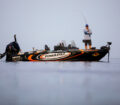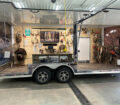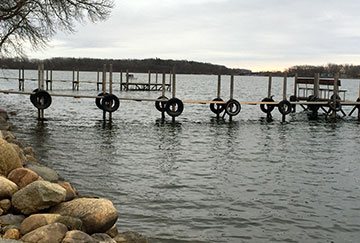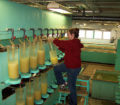By Bob Jensen
Fishing the Midwest Fishing Team

Fishing guide Kevan Paul used a long rod to dip his jig into early season rushes in his successful search for a crappie.
Spring came, winter returned, then spring re-entered the picture. People who like to fish are optimistic that the warmer weather will stay with us this time, and that means it’s time to think about going fishing. For many of us, the first fishing trip of the open water season is in search of crappies.
In some areas, fishing season for walleyes, bass, and other species isn’t open yet, but we can chase crappies and other panfish. If you want to get after some crappies right now, following are some ideas that could lead to success.
Crappies can be very accessible early in the fishing season. They can be taken from a boat, but they can also be caught from a dock or the shoreline. Crappies are abundant in much of North America and can be willing biters this time of year. Additionally, many people who like to eat fish know that it’s pretty hard to beat a crappie on the plate.
When it comes to fishing, just like any other time of the year, if you want to catch’em, ya’ gotta’ find’em. Crappies will be around some form of cover most of the time. The cover could be vegetation like reeds, a tree that has fallen in the water, or a dock.
Early in the year, search out warm water with cover that’s near deep water and you’ll probably have crappies within casting range. Crappies like to have access to deep water. If winter returns unexpectedly, they’ll move quickly to the deeper water. They’ll also move there after they spawn.
Once we’ve located an area that looks like it should be home to some crappies, we need to try to get them to eat our bait. Several presentations will work, but probably the most popular and effective, when done properly, is to cast a jig or fish it under a slip-bobber. Slip-bobbers allow an angler to cast easily and present a bait right in the crappie’s face.
Start with a sixteenth ounce jig-head and a plastic tail. Color is one of the things you’ll need to experiment with, as sometimes the crappies can be selective. Some very successful crappie catchers like a black jig because the bugs that are hatching early in the year are black. Other crappie-catchers like a jig/tail combo that has some pink, chartreuse, or orange.
Mr. Crappie Wally Marshall has fished for crappies pretty much wherever crappies live, and he’s found that natural colors in clear water and bright colors in dark water are a good starting point. However, if he had to choose colors to catch a crappie anywhere, anytime, those colors would be Hot Chicken.com or Refrigerator White.
Plastic tails are available in many shapes. Some tails, something like a Mr. Crappie Grub, has more action and is better when slowly retrieved. Other tails don’t have as much action. They’ll certainly produce when slowly retrieved, but they also work very well under a bobber. A Mr. Crappie Crappie Thunder or Crappie Tube have more subtle actions.
More and more, crappie chasers are using ten to twelve foot long telescoping pole for their crappie fishing. Some of these rods employ a reel, but others have just a length of eight or ten pound test line tied to the tip guide of the rod. Line length depends on how deep you’ll be fishing. Much of the time six to eight feet of line is all you’ll need.
These anglers just dip their jig into holes in the reeds, along docks, or any other shallower cover that might be home to a crappie. I’ve participated in this close-in crappie dipping with my twelve foot long Bream Stick rod several times and have enjoyed and been successful almost every time.
Crappie action can be very good right now. Keep a few if you want, put the rest back, and we’ll all be able to enjoy this early season action for a long time.

















